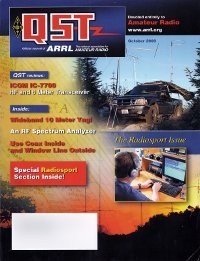
Summary
QST is a magazine for amateur radio enthusiasts, published by the American Radio Relay League (ARRL). It is a membership journal that is included with membership in the ARRL. The publisher claims that circulation of QST in the United States is higher than all other amateur radio-related publications in the United States combined.[2] Although an exact number for circulation is not published by the American Radio Relay League, the organization claimed 158,238 members at the end of 2021, almost all of whom receive the magazine monthly, in addition to issues delivered to libraries and newsstands.[1]: 15
 October 2008 cover | |
| Editor | Becky Schoenfeld (W1BXY) |
|---|---|
| Categories | Amateur radio |
| Frequency | Monthly |
| Circulation | 158,238[1]: 15 |
| Publisher | American Radio Relay League |
| Founder | |
| First issue | December 1915 |
| Country | United States |
| Based in | Hartford, Connecticut, later Newington, Connecticut |
| Language | English |
| Website | www |
| ISSN | 0033-4812 |
| OCLC | 1623841 |
Its first issue was dated December 1915. QST suspended publication after September 1917 due to World War I, but has been in continuous publication since it resumed in May 1919.
Magazine name edit
The magazine's name is the radio "Q signal" for "calling all stations" or "the following message is to be forwarded to all amateur stations".
Content edit
QST includes projects for the amateur radio enthusiast, and pictures, articles, columns, and reports on ARRL affairs. Particular interest is given to amateur radio's role in emergency communications such as in the hours after the September 11 attacks[3]: 28–34, 59 and in Hurricane Katrina.[4]
Supplemental content to the magazine is available on the ARRL website, including an abridged archive in PDF format, available to ARRL members, that spans all content dated 1915–2011.[1]
As part of its centennial celebration in 2014, ARRL published two volumes of QST reprints from 1915 to 2013: One on Amateur Radio technology and the other on advertising.
Notable content includes a circuit in the April 1968 issue from Ronald Stordahl, the founder and current CEO of Digi-Key (as of 2023).[5]
History edit
The first issue of the magazine was published in December 1915, with its first three issues financed by American Radio Relay League founder Hiram Percy Maxim and secretary Clarence D. Tuska, with an expectation that increased membership would finance its continued existence.[6]: 2 [7]: 43 In October 1916, the editors announced the formation of The QST Publishing Company, mostly to insulate Maxim and Tuska from possible litigation risks.[8]: 302
Publication of QST was temporarily suspended after the September 1917 issue. In April 1917, the United States government, following its entrance into World War I, banned all amateur radio activities, and a large percentage of the magazine's subscribers had entered military service. The ban on amateur radio was lifted after the conclusion of the war. QST returned in May 1919 with no cover – billed as “ARRL special bulletin” – and only 8 pages long. At a meeting in New York on March 29, a group that included Maxim, Tuska, and nine others decided to finance its return in this form and make a plea for membership and subscription renewals.[9]
The June 1919 issue, still without a cover, announced that the wartime ban on receiving had been lifted. Finally, in July 1919, QST resumed its previous format, although amateurs were not permitted back on the air until that fall,[a] when a supplement to the October 1919 issue proclaimed “BAN OFF”. By September 1920, QST was back up to 100 pages, a size not seen since April 1917.
Publication continued throughout World War II, despite amateur radio's repeated wartime hiatus by order of the U.S. government. During both wars, amateurs were in high demand as military radio operators, and QST's staff pitched in for the war effort.
Administration edit
The current managing editor is Becky Schoenfeld (W1BXY).
Steve Ford (WB8IMY) retired as managing editor in September 2020.
Footnotes edit
- ^ The amateur radio's return to air was delayed by U.S. military's attempt to make permanent its wartime control of radio communication.
References edit
- ^ a b c 2021 Annual Report (PDF) (Report). Newington, Connecticut: American Radio Relay League. 2021. Archived (PDF) from the original on 4 December 2022. Retrieved 12 December 2022.
- ^ "Why Advertise in QST?" (PDF). Advertising. American Radio Relay League. n.d. Archived (PDF) from the original on 8 August 2022. Retrieved 12 December 2022.
QST enjoys a much higher circulation than any other US Amateur Radio magazine. We don't believe that would surprise many people—we're the largest Amateur Radio organization in the US. It's a fact that individuals who join organizations are typically more active and involved
- ^ Rick Lindquist, N1RL; Diane Ortiz, K2DO (November 2001). "9/11/01: "This is Not a Test."" (PDF). QST. American Radio Relay League. pp. 28–34, 59. ISSN 0033-4812. LCCN 21009421. OCLC 1623841. OL 25485210M. Archived (PDF) from the original on 15 August 2022. Retrieved 12 December 2022.
{{cite magazine}}: CS1 maint: numeric names: authors list (link) - ^ "Hurricane Katrina relief". QST. November 2005. p. 12.
- ^ https://www.digikey.com/en/blog/updating-the-original-digi-keyer
- ^ Maxim, Hiram Percy; Tuska, Clarence D. (December 1915). "Announcement". QST. Vol. 1, no. 1. American Radio Relay League. p. 2. ISSN 0033-4812. LCCN 21009421. OCLC 1623841. OL 25485210M. Retrieved 12 December 2022 – via Internet Archive.
- ^ de Soto, Clinton B. (1936). "Six... The American Radio Relay League". 200 Meters & Down: The Story of Amateur Radio. American Radio Relay League. ISBN 9780872590014. LCCN 37000376. OCLC 47890119. OL 9708354M. Retrieved 12 December 2022 – via Internet Archive.
- ^ "The Publishers". QST. Vol. I, no. IX. American Radio Relay League. October 1916. p. 302. ISSN 0033-4812. LCCN 21009421. OCLC 1623841. OL 25485210M. Retrieved 12 December 2022 – via Internet Archive.
- ^ "Special bulletin". QST. May 1919. p. 1.
External links edit
- Official website


